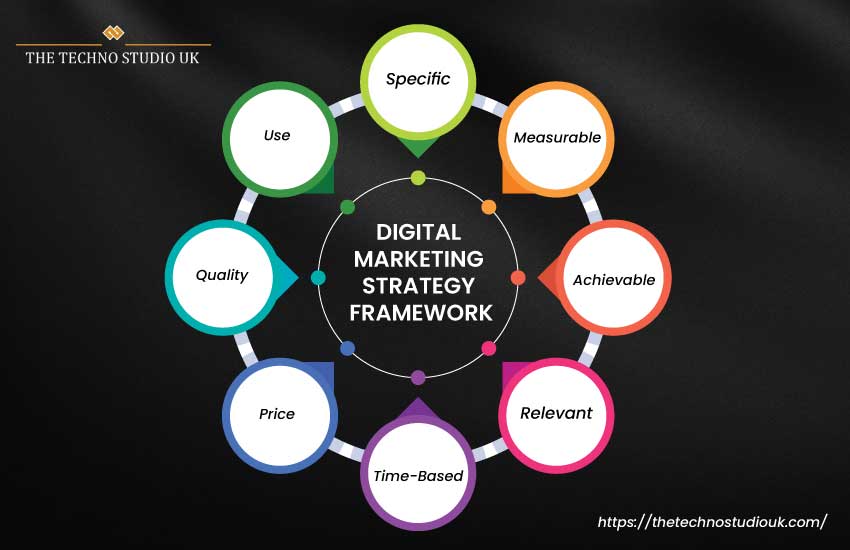In today’s fast-paced digital world, a well-structured digital marketing strategy is crucial for businesses looking to establish a strong online presence, reach their target audience, and drive growth. Crafting an effective digital marketing strategy involves a blend of creativity, data analysis, and a deep understanding of the ever-evolving online landscape. In this article, we’ll explore a comprehensive digital marketing strategy framework that encompasses key elements to help businesses succeed in the digital realm.
Table of Contents
- Introduction
- Understanding Your Business Goals
- Identifying Your Target Audience
- Competitor Analysis: Gaining a Competitive Edge
- Selecting the Right Digital Channels
- Content Creation and Distribution
- Search Engine Optimization (SEO) Strategies
- Paid Advertising and Campaign Management
- Social Media Engagement
- Email Marketing: Nurturing Customer Relationships
- Data Analytics and Tracking
- Adapting to Trends and Updates
- Measuring ROI and Performance
- Scaling and Iterating Your Strategy
- Conclusion
1. Introduction
In the era of digital dominance, a strategic approach to marketing is essential for businesses to stand out amidst the noise. A well-crafted digital marketing strategy framework provides a roadmap for achieving business objectives and staying relevant in the competitive online landscape.
2. Understanding Your Business Goals
Before diving into digital marketing tactics, it’s crucial to define clear and measurable business goals. Whether it’s increasing brand awareness, driving website traffic, or boosting sales, a crystal-clear understanding of your objectives lays the foundation for a successful strategy.
3. Identifying Your Target Audience
Knowing your audience is the cornerstone of effective marketing. Research and segment your audience based on demographics, preferences, and behaviors. This insight allows for personalized campaigns that resonate with your target audience.
4. Competitor Analysis: Gaining a Competitive Edge
Analyzing your competitors’ digital strategies helps identify gaps and opportunities in the market. By understanding their strengths and weaknesses, you can position your brand strategically and offer unique value to your audience.
5. Selecting the Right Digital Channels
Not all digital channels are created equal. Depending on your target audience and goals, choose the platforms that align with your strategy. Whether it’s social media, content marketing, or paid advertising, each channel has its own strengths.
6. Content Creation and Distribution
Compelling content is the currency of the digital world. Create high-quality, relevant content that addresses your audience’s pain points and interests. Distribute this content across various channels to increase visibility and engagement.
7. Search Engine Optimization (SEO) Strategies
A robust SEO strategy ensures your website ranks high in search engine results. Optimize your content with relevant keywords, improve website speed, and focus on creating an exceptional user experience.
8. Paid Advertising and Campaign Management
Paid advertising accelerates your reach and drives targeted traffic. Platforms like Google Ads and social media ads allow for precise audience targeting. Effective campaign management involves monitoring, optimizing, and adjusting strategies for maximum ROI.
9. Social Media Engagement
Social media platforms are powerful tools for building brand identity and engaging with your audience. Craft a consistent posting schedule, interact with followers, and leverage visual content to create a strong online presence.
10. Email Marketing: Nurturing Customer Relationships
Email marketing remains an effective way to nurture leads and maintain customer relationships. Personalize your emails, offer value-driven content, and utilize automation to streamline communication.
11. Data Analytics and Tracking
Data is a goldmine of insights. Use analytics tools to track key performance indicators (KPIs) and adjust your strategy accordingly. Monitor user behavior, conversion rates, and other metrics to refine your approach.
12. Adapting to Trends and Updates
The digital landscape is ever-changing. Stay updated on industry trends and algorithm changes. Embrace new technologies and adapt your strategy to stay ahead of the curve.
13. Measuring ROI and Performance
Measuring the success of your digital marketing efforts is crucial. Calculate ROI by analyzing the revenue generated against the costs incurred. Regularly assess performance to make informed decisions.
14. Scaling and Iterating Your Strategy
As your business grows, your digital marketing strategy should evolve. Scale successful campaigns and experiment with new approaches. Continuous iteration ensures your strategy remains effective.
15. Conclusion
Crafting a successful digital marketing strategy requires a holistic approach that integrates various elements. By aligning your business goals, understanding your audience, and leveraging the right channels, you can create a strategy that drives growth and fosters long-term success.




